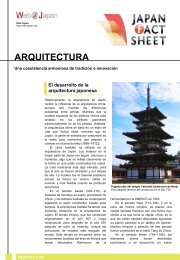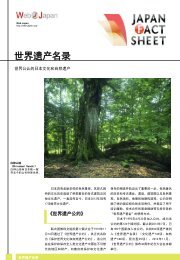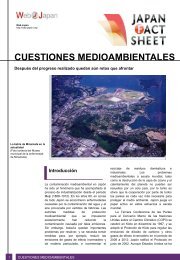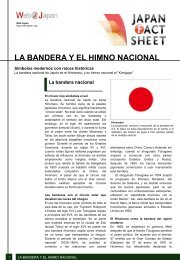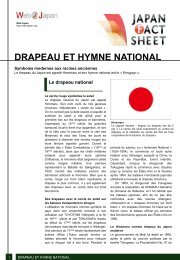Art - Web Japan
Art - Web Japan
Art - Web Japan
You also want an ePaper? Increase the reach of your titles
YUMPU automatically turns print PDFs into web optimized ePapers that Google loves.
The National <strong>Art</strong> Center<br />
A transparent atrium is<br />
characteristic<br />
Culture in <strong>Japan</strong> underwent a rather dramatic<br />
transformation during the Meiji period, when<br />
Western technologies and concepts of<br />
government began to be studied and, where<br />
appropriate, adapted for the good of the<br />
nation. In the course of this program of<br />
modernization, Western-style painting<br />
received official sanction, and the government<br />
sent a number of painters overseas to study.<br />
After some decades of rivalry between<br />
traditional <strong>Japan</strong>ese-style and the new<br />
Western-style painting, the Taisho period<br />
(1912–1926) was one in which Western<br />
influence on the arts expanded greatly.<br />
Modern Times<br />
Painters such as Umehara Ryuzaburo and<br />
Yasui Sotaro studied and promoted the styles<br />
of Paul Cezanne, Pierre Auguste Renoir, and<br />
Camille Pissarro.<br />
In the pre-World War II years, however,<br />
Yasui and Umehara cast off the mostly<br />
derivative character of Western-style painting<br />
in <strong>Japan</strong>. Umehara stands out for having<br />
brought to his work elements of <strong>Japan</strong>ese<br />
style, an innovation reversal that encouraged<br />
other Western-style painters in <strong>Japan</strong> to<br />
become more interpretative.<br />
The modernizing of <strong>Japan</strong>ese painting<br />
continued under the guidance of Yasuda<br />
Yukihiko and Kobayashi Kokei. Other painters<br />
tried to spread interest in <strong>Japan</strong>ese-style<br />
painting by adopting popular themes and<br />
giving exhibitions more frequently.<br />
It was early in the twentieth century that<br />
authentic interest in Western-style sculptures<br />
gained momentum, when artists returned to<br />
<strong>Japan</strong> from study abroad. Representative of<br />
those sculptors was Ogiwara Morie, who<br />
introduced the style of Auguste Rodin and<br />
became the pioneer in the modernization of<br />
<strong>Japan</strong>ese sculpture. Another influential<br />
sculptor was Takamura Kotaro who, as an<br />
outstanding poet as well, translated Rodin’s<br />
views on art.<br />
Following the unproductive years of World<br />
War II, art in <strong>Japan</strong> rapidly regained its<br />
originality. Western artistic trends, after the<br />
war, found a quick reception in <strong>Japan</strong>,<br />
including such developments as pop and op<br />
art, primary structure, minimal art, kinetic art,<br />
and assemblage.<br />
Having traditionally taken their lead from<br />
the art of other cultures, <strong>Japan</strong>ese artists are<br />
now finding their own expression as original<br />
creators and contributors to the world art<br />
community. To mention a couple: Okamoto<br />
Taro, who published his works at the 1953<br />
São Paulo Biennale and 1954 Venice<br />
Biennale, and designed the symbol of the<br />
international exposition held in Osaka in 1970,<br />
Taiyo no To (Sun Tower); and Ikeda Masuo,<br />
who published many printed works full of<br />
eroticism and irony, which established his<br />
fame worldwide. Ikeda also won the Grand<br />
Prix for printmaking at the 1966 Venice<br />
Biennale. Additionally, Hirayama Ikuo is<br />
highly respected for his pictures depicting Silk<br />
Road landscapes filled with fantasy. Iwasaki<br />
Chihiro, who painted pictures for children, is<br />
widely acclaimed for her portraits of them.<br />
Most of her pictures were painted for picture<br />
books, and these books are published in<br />
more than 10 countries. The artist Kusama<br />
Yayoi, who began by trying to capture the<br />
hallucinations which she suffered from as a<br />
child, creates paintings and other works with<br />
a repetitive motif of dots and net patterns and<br />
has exhibited in galleries and exhibitions all<br />
over the world. <strong>Art</strong>ists such as Nara<br />
Yoshitomo, whose pictures of little girls with<br />
glowering eyes depict a world which is both<br />
cute and eerie, and Murakami Takashi, who<br />
draws on the typically <strong>Japan</strong>ese culture of<br />
manga and anime for his life-sized figures of<br />
young women, etc., are very popular,<br />
especially among young people.<br />
4 ART



